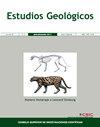Procedencia del material pétreo de los molinos de los yacimientos Cogotas I (Bronce Medio y Tardío) de la Cuenca del Duero y modelos consecuentes de flujo
IF 0.8
4区 地球科学
Q3 GEOLOGY
引用次数: 3
Abstract
The source provenance of twelve hand grindstones of Cogotian sites from the sedimentary Duero Basin was characterized using petrographic, mineralogical and geochemical criteria, according to an operational process previously proposed. Many of the provenances were determined after trace-element normalized diagrams and comparative diagrams with respect to available data from potential source areas. This methodology confirms that the geochemical signature can be seen as an archaeological fingerprint which allows the identification of facies or rock sub-types from the established source areas. Granite sources are the commonest provenance, although granodiorite, orthogneisses and sandstone are also involved, all of them belonging to the Variscan Basement. One of these source areas includes copper minerals, which could have been used for metallurgical purposes. Probably, since the early phase of Cogotas I, the principle of least effort no longer was a guiding force to boost the supply of material. The archaeological sites experienced a long-distance raw material supply in crossed directions, according to the established sources areas, indicating a dense network of connections between the commnunities of the region at a hecto-kilometric scale.杜罗盆地Cogotas I矿床(中青铜和晚期青铜)磨石材料的来源和随后的流动模型
采用岩相学、矿物学和地球化学标准,按照前人提出的操作方法,对Duero盆地cogolan遗址的12个手磨石进行了物源鉴定。许多物源是根据来自潜在源区的可用数据的痕量元素标准化图和比较图确定的。这种方法证实,地球化学特征可以被视为一种考古指纹,可以从已确定的烃源区识别相或岩石亚型。花岗闪长岩、正长岩和砂岩均属于瓦立斯坎基底,但花岗闪长岩是最常见的物源。其中一个来源地区包括铜矿物,可以用于冶金目的。也许,从Cogotas I的早期阶段开始,最少努力的原则就不再是促进材料供应的指导力量。根据已确定的来源区域,考古遗址在交叉方向上经历了长距离的原材料供应,表明该地区社区之间在百公里尺度上存在密集的连接网络。
本文章由计算机程序翻译,如有差异,请以英文原文为准。
求助全文
约1分钟内获得全文
求助全文
来源期刊

Estudios Geologicos-Madrid
GEOLOGY-
CiteScore
1.40
自引率
14.30%
发文量
6
审稿时长
>12 weeks
期刊介绍:
Since 1945 Estudios Geologicos publishes original research works, as well as reviews, about any topic on Earth Sciences.
Estudios Geologicos is published as one yearly volume, divided into two half-yearly issues. It is edited by the Spanish National Research Council (Consejo Superior de Investigaciones Científicas, CSIC) at the Instituto de Geociencias (CSIC-UCM).
Estudios Geologicos provides free access to full-text articles through this electronic edition. Accepted articles appear online as "Forthcoming articles" as soon as the galley proofs have been approved by the authors and the Editor-in-Chief. No changes can be made after online publication.
 求助内容:
求助内容: 应助结果提醒方式:
应助结果提醒方式:


